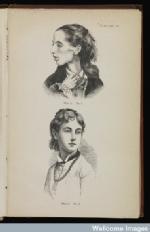Seminar 7: Adolescent Bodies
 |
This week’s seminar examines changing ideas of youth as a time of both great opportunity and of risk during the late nineteenth and twentieth centuries. We will focus particularly on changing ideas on menstruation and its impact on the health of young women. We will also examine concern about the rising incidence of anorexia nervosa and consider changing explanations for its prevalence from the time that it was first recognised and labelled in 1874 to the late twentieth century. |
Seminar Reading:
Please read at least two of the following plus the primary sources:
Julie-Marie Strange, ‘The Assault on Ignorance: Teaching Menstrual Etiquette in England, c.1920s to 1960s’, Social History of Medicine, 14 (2001), 247-65. e-resource Oxford journals
I.S.L. Loudon, ‘Chlorosis, Anaemia, and Anorexia Nervosa’, British Medical Journal, 281 (20-27 Dec. 1980), 1669-75. e-resource JSTOR
Hilary Marland, Health and Girlhood in Britain, 1874-1920 (Houndmills: Palgrave Macmillan, 2013) Chapter 1: Unstable Adolescence: Medicine and the 'Perils of Puberty' in Late Victorian and Edwardian Britain, pp.15-41. e book
Primary Sources
Pat Jalland and John Hooper (eds), Women From Birth to Death: The Female Life Cycle in Britain 1830-1914 (Brighton: Harvester, 1986), Part 2 ‘Menstruation and Adolescence’. Extracts to be circulated.
Health Promotion film A Cruel Kindness (1967) (available on YouTube and Wellcome Library).
Additional Reading:
Susan Bodo, ‘Reading the Slender Body’, in Mary Jacobus, Evelyn Fox Keller and Sally Shuttleworth (eds), Body/Politics: Women and the Discourses of Science (London: Routledge, 1990), 83-112.
Susan Bordo, Unbearable Weight: Feminism, Western Culture, and the Body (Berkeley and London: University of California Press, 1993), esp. Part Two ‘The Slender Body and Other Cultural Forms’, 139-212.
Hilde Bruch, Eating Disorders: Obesity, Anorexia Nervosa and the Person Within (New York: Basic Books, 1973).
Hilde Bruch, The Golden Cage: The Enigma of Anorexia Nervosa (London: Open Books, 1978).
Joan Jacobs Brumberg, Fasting Girls: The History of Anorexia Nervosa (Cambridge, MA: Harvard University Press, 1988).
Joan Jacobs Brumberg, ‘From Psychiatric Syndrome to “Communicable” Disease: The Case of Anorexia Nervosa’, in Charles E. Rosenberg and Janet Golden (eds), Framing Disease: Studies in Cultural History (New Brunswick, NJ: Rutgers University Press, 1992), 134-54.
Carol Dyhouse, Girls Growing up in Late Victorian and Edwardian England (London: Routledge & Kegan Paul, 1981).
Karl Figlio, ‘Chlorosis and Chronic Disease in Nineteenth-Century Britain: The Social Construction of Somatic Illness in a Capitalist Society’, Social History, 3 (1978), 73-107. e-resource JSTOR/Taylor & Francis
Deborah Gorham, The Victorian Girl and the Feminine Ideal (London and Camberra, Croom Helm, 1982).
Bruce Haley, The Healthy Body and Victorian Culture (Cambridge, MA and London: Harvard University Press, 1978).
Harry Hendrick, Images of Youth: Age, Class, and the Male Youth Problem, 1880-1920 (Oxford: Clarendon, 1990).
Mark Jackson, '"Grown-Up Children": Understandings of Health and Mental Deficiency in Edwardian England', in Marijke Gijswijt-Hofstra and Hilary Marland (eds), Cultures of Child Health in Britain and the Netherlands in the Twentieth Century (London and New York: Rodopi, 2003), 149-68.
Mark Jackson, The Borderland of Imbecility: Medicine, Society and the Fabrication of the Feeble Mind in Late Victorian and Edwardian England (Manchester: Manchester University Press, 2000).
J.A. Magnan, Athleticism in the Victorian and Edwardian Public School (Cambridge: Cambridge University Press, 1981).
Hilary Marland, Health and Girlhood in Britain, 1874-1920 (Houndmills: Palgrave-Macmillan, 2013), especially chs. 1 and 2. e-book
Hilary Marland and Roberta Bivins, 'Weighting for Health: Management, Measurement and Self-Surviellence in the Modern Household, Social History of Medicine, 29 (2016), 757-80. e-journal
Emily Martin, ‘Premenstrual Syndrome: Discipline, Work and Anger in Late Industrial Societies’, in Thomas Buckley and Alma Gottlieb (eds), Blood Magic: The Anthropology of Menstruation (Berkeley, CA: University of California Press, 1988), 161-88.
Susie Orbach, Hunger Strike: The Anorexic’s Struggle as a Metaphor for our Age (London and Boston: Faber & Faber, 1986).
Hillel Schwartz, Never Satisfied: A Cultural History of Diets, Fantasies and Fat (London: Collier Macmillan, 1986).
Elaine Showalter and English Showalter, ‘Victorian Women and Menstruation’, in Martha Vicinus (ed.), Suffer and be Still: Women in the Victorian Age (London: Methuen, 1980), 38-44.
John Springhall, Youth, Empire and Society: British Youth Movements 1883-1940 (London: Croom Helm, 1977).
Julie-Marie Strange, 'Menstrual Fictions: Languages of Medicine and Menstruation, c.1850-1930', Women's History Review, 9 (2000), 607-28. e-resource Taylor & Francis
Deborah Thom, 'The Healthy Citizen of Empire or Juvenile Delinquent?': Beating and Mental Health in the UK', in Marijke Gijswijt-Hofstra and Hilary Marland (eds), Cultures of Child Health in Britain and the Netherlands in the Twentieth Century (London and New York: Rodopi, 2003),189-212.
Walter VanderEycken and Roth van Deth, From Fasting Saints to Anorexic Girls: The History of Self-Starvation (London: Athlone, 1994).
Essay Questions
Why was adolescence deemed a time of risk as well as opportunity in terms of health and development in the late nineteenth and early twentieth centuries?
To what extent was menstruation treated as a 'disease' in nineteenth- and twentieth-century Britain?
Can anorexia nervosa be framed as a physciatric disorder or culturally-bound syndrome, or both?
